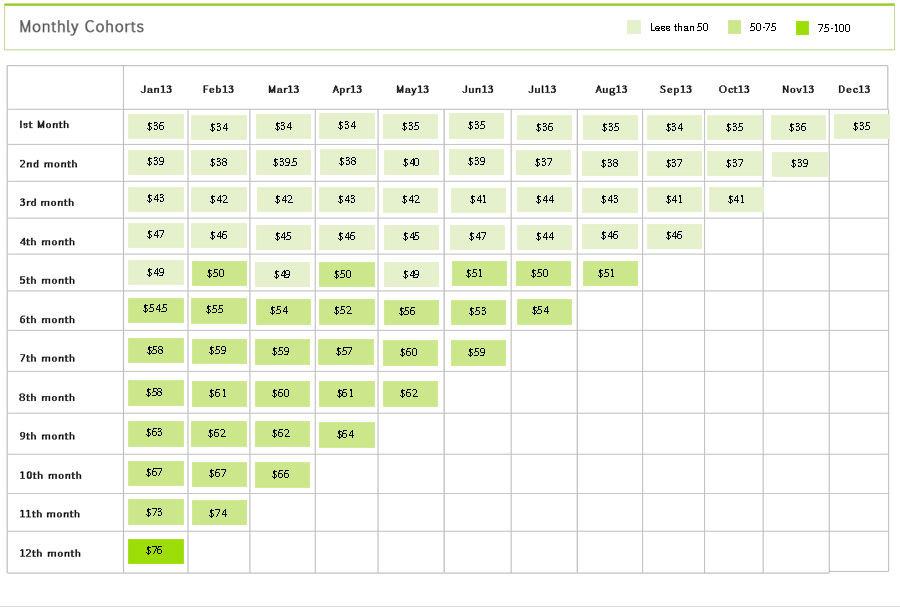
Cohort analysis helps measure users who share common characteristics over a period of time. Cohort Analysis can be used to measure subscription attrition, user engagement or to estimate lifetime value. For example, when we do a cohort anlaysis for understanding traction in user engagement, we group people based on their joining date. The people who joined our service in January make up the January cohort, the people who joined in February make up the February cohort, and so on which is further analyzed to understand how each cohort stays engaged over time.
For an e-commerce business, rather than looking at the number of engaged users per cohort, the focus should be on the net revenue from that cohort in a given period. This revenue has to be normalized by dividing by the number of (original) buyers in each cohort so that you can make meaningful comparisons. You should focus on revenue per (original) buyer in each period for each cohort as the raw data from which you can build a lifetime value analysis. Then you should average across cohorts to understand “typical” revenue per customer.
To measure the performance of an e-commerce business, the two important metrics are LifeTimeValue /Customer Acquisition Cost ratio and payback period. Lifetime value is calculated as the cumulative contribution of an average customer, so you have to multiply lifetime revenue by contribution margin. Contribution margin should include COGS, packaging, shipping and handling, reverse logistics, inventory obsolescence /write offs, customer service, credit card charges, hosting costs, fraud accruals etc. but excluding fixed costs such as marketing asset development.
Cohort Analysis is important as the marketer can separate engagement metrics from business growth metrics. For example, If there are more sign-ups, the overall engagement metrics will look positive because those new users are relatively well-engaged initially. But in reality, after a couple of weeks, their activity could decline. But these engagement metrics are masked by the growing new users…who show great activity and intent during this period.
By bucketing people into the month (or week) they started using the service; you can keep track of their engagement over time. You can now make assessments like “the Feb cohort is engaged better than the Jan cohort” and the likes.
Cohort Analysis by Purchases

Breakup by Cohorts

Now lets group each cohort and analyze their engagement. For example, let’s see how the Jan cohort performed across months.

A deep dive report will show us how each member of the cohort performed and how rules can be assigned to automate engagement and cross-selling strategies. You will see that the total cohort count of 20 has reduced to 8 by the end of six months but the average purchase value has increased from $36.25 to $52.50.
Here is a sample of an online web services package which has 3 types of packages ranging across $35, $40 and $60. Based on frequency of transaction or the package purchased, you can set rules to position your campaign to the customer in the cohort.

4 regular customers who do more than $200 transaction and are now buying the premium package. Here, in this report, we have a variety of cases. You can see the following types:
4 customers who average $150 transaction are now consistently purchasing $40 package and should be recommended the premium package.
7 customers purchased once and never returned. Need some engagement here.
2 customers bought $35 package every quarter. Strategy to increase revenue with this customer.
The rules engine has assigned the relevant campaign against each customer based on the rule settings by the marketing manager.
Rule 1: Assign Engagement Campaign if customer frequency is less than 2, which means the customer has made only one purchase in the given time frame
Rule 2: Assign Upsell Rules Campaign (Template A) if customer frequency is more than 2 and package details has Package35 only,
Rule 3: Assign Upsell Rules Campaign (Template B) if customer frequency is more than 2 and package details has Package35 & 40
Rule 3: Assign Feedback Campaign if customer frequency is more than 2 and package details has Package60
All rules can be set by the marketing manager to run continuous campaigns to pursue effective conversions resulting in higher revenue per customer.
